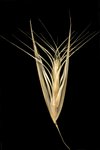
T. avenoides spikelet.
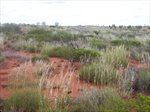
T. avenoides habitat.
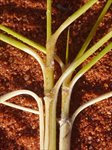
T. avenoides orifice.
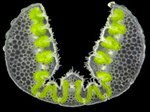
T. avenoides leaf section.
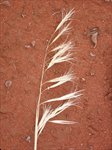
T. avenoides inflorescence.
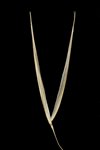
T. avenoides glumes.

T. avenoides lemma.
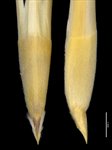
T. avenoides lemma bases.

T. avenoides paleas.
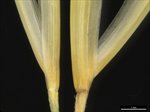
Comparison of T. avenoides (right) and T. schinzii (left) glume bases, showing difference in width.

T. avenoides (right) and T. schinzii (left) lemma base comparison, showing difference in lemma width.

T. avenoides map.
Name
Triodia avenoides M.D.Barrett, ined.
Citation
Nuytsia, in press, (2017)
Derivation
avenoides— from the Latin avena (wild oat) and –oides (Greek adjectival suffix indicating similarity), in reference to the similarity of the open inflorescence, especially when the glumes are empty, to the Common Oat, Avena sativa.Common name
Western Feathertop Spinifex
Synonyms
None
Diagnostic features
Foliage resinous; leaf sheath surfaces glabrous; leaf blades epistomatous (soft-type); orifice hairs straight to tangled; lower glume narrowly lanceolate, L:W>6, 12.5–32 mm long, (2.1–)2.2–3.6 mm wide; lemmas 3-awned, bitextured, the lower indurated part uniformly covered with ±appressed hairs; lemma body 1.4–1.8 mm wide; callus sharply pungent, 0.8–1 mm long; palea bitextured, lacking hairs; on dunes and sand plains in the Carnarvon bioregion and immediately adjacent parts of other sub-regions in the west Pilbara.
Habitat
Occurs on red sand dunes or on deep red sand plains
Distribution and frequency
Endemic to the sands of the Carnarvon Basin in the west Pilbara and Carnarvon bioregions, where it is widespread but patchy
Similar species
Triodia avenoides belongs to the Soft group, sharing the epistomatous (soft-type) leaf blades.
Most similar to T. schinzii, sharing the narrowly lanceolate glumes, 3-awned and bitextured lemmas, and sharply acute callus ≥0.8 mm long. Triodia avenoides differs from T. schinzii in having lemma body 1.3–1.8 mm wide (0.8–1.25 mm wide in T. schinzii), broader glumes (2.1–)2.2–3.6 mm wide [1.5–2.1(–2.2) mm wide in T. schinzii], 2–3 spikelets on the longest (basal) panicle branches (3–5 spikelets in T. schinzii), and a non-overlapping distribution. Triodia avenoides occurs on sands of the Carnarvon Basin west of the Pilbara, while T. schinzii occurs to north and east, on sands of the Dampierland, Great Sandy Desert and Little Sandy Desert, extending into the Pilbara on sand plains between Port Hedland and Karratha, in patches in the eastern Chichester west to Abydos and Woodstock stations, and along the Fortescue Valley east of Munjina (Auski).
Several species sharing awned lemmas and bitextured lemma body occur in the Pilbara. Other than T. schinzii discussed above, all occur on rocky substrates. Triodia basitricha differs in having smaller glumes, and hairs on the surface of the leaf sheaths (glabrous in T. avenoides).
Triodia sp. Mt Ella differs in having a hairy palea, shorter glumes ≤12.5 mm long and a shorter callus ≤0.7 mm long (palea glabrous, glumes ≥15 mm, callus long-pungent and ≥0.8 mm in T. avenoides).
Triodia degreyensis differs in having a hairy palea, generally shorter glumes 12.4–17 mm long and a shorter callus <0.5 mm long (palea glabrous, glumes 12.5–32 mm long, callus long-pungent and ≥0.8 mm in T. avenoides), as well as occurring on a rocky substrate and a disjunct distribution.Conservation status
Not considered at risk.
Identification without florets
The only other species with either resinous foliage or epistomatous leaves in the West Pilbara is T. epactia, which has much shorter and broader glumes (L:W4) and lacks lemma awns.
Variation
A relatively uniform species.
Notes
Triodia avenoides was treated as part of T. schinzii by Lazarides (1997), Lazarides et al. (2005) and Ausgrass (Sharp & Simon, 2002; Simon & Alonso, 2014). A full description can be found in Barrett (2017b).
Probably palatable to stock when young.